American RV installs a set of Lance cabover struts on TCM’s Chevy 3500 for a test and review. Will the struts fix the dreaded highway ga-dunk ga-dunk?

The History of Cabover Struts
Thanks to Bob Livingston, Publisher at Good Sam Enterprises, and some very generous readers over the years, I have accumulated a fantastic collection of Camper Coachman magazines from the late 1960s and early 1970s. Camper Coachman was the first dedicated “truck camper magazine”, only it was published on something called paper, and physically delivered through the postal mail. What a concept.
When researching how we were going to tackle a test and review of cabover struts, it made sense to start with the history of the concept and product. A cursory exploration of any copy of Camper Coachman immediately reveals a stark truth; cabover struts were very common in the 1960s and 1970s. If the photographs of truck camper rigs in my Camper Coachman collection are any indication, about 40% of all truck campers had cabover struts in this time period, possibly more.
I was also shocked (no pun intended) to find not one, but many manufacturers of cabover struts in the pages of Camper Coachman. Even more fascinating, there were several competing designs and approaches to cabover struts, all of them designed to tackle two key problems; highway porpoising and excess camper motion.
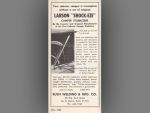 |
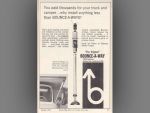 |
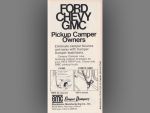 |
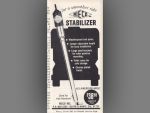 |
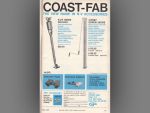 |
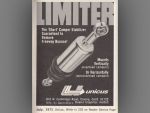 |
Above: Larson Shock-Eze Camper Stabilizers, Bounce-A-Way, Camper Dampers, Rieco Stabilizers, Coast Fab, and Limiter Stabilizers (click photos for details)
What exactly happened to cabover struts? How is it that forty years later there is only one cabover strut manufacturer?
What Happened to Cabover Struts?
It may be hard to believe today, but there were literally dozens of truck camper manufacturers in the late 1960s and early 1970s. In fact, there were at least fifty small independent truck camper manufacturers all over the United States and Canada during the industry’s early 1970s peak.
Then, starting with the fuel crisis of 1973, it all started going south for the truck camper industry. By the time the 1978 fuel crisis hit, the truck camper market was struggling. Already weakened, only the strongest truck camper manufacturers would survive the recession of 1981 and 1982.
During that same time period, motorhomes became the popular trend. Camper Coachman was rolled into another magazine in 1975 and phased out soon thereafter. By the time 1985 rolled around, truck campers, like Camper Coachmen, were all but irrelevant to the greater RV marketplace. Although truck campers are a successful product category today, they still remain a small niche of the overall RV industry.
To answer the question, “What happened to cabover struts?” you need to answer the question, “What happened to truck campers?”. When the truck camper marketplace collapsed starting with the fuel crisis of 1973, so did the truck camper gear marketplace. Again, any copy of Camper Coachman from the late 1960s and early 1970s reveals fifty or more truck camper gear companies and products that no longer exist today. When the truck camper marketplace collapsed, so did the cabover strut companies.
Cabover Struts Today
Of course that’s not the whole story. One manufacturer, Lance Campers, still offers and promotes cabover struts. In stark contrast, no other truck camper manufacturer or gear company currently sells or recommends cabover struts. Essentially, the once popular cabover strut has become a one company crusade.
So another important question to ask is, “Why don’t non-Lance manufacturers and dealers recommend cabover struts?”
The answer to this question is a bit more complex. First, significant advancements to the design and manufacturing quality of truck campers has greatly improved the weight distribution, center of gravity, and overall quality of modern truck campers.
Second, significant advancements to the design and manufacturing quality of trucks has greatly improved the handling, payload capacity, and overall quality of modern trucks. When properly matched together, modern truck camper rigs generally handle better and suffer less from the very issues cabover struts are designed to address; highway porpoising and excess camper motion.
Finally, many of the truck camper industry leaders of the late 1960s and early 1970s are no longer participating in the industry. These are the folks who once designed, manufactured, advocated, and finally installed cabover struts. In their absence, cabover struts have simply lost their voice.
Today, most truck camper industry leaders and consumers see cabover struts as old fashioned band-aids that are no longer necessary with modern truck campers. The next question is, “Are they right?”
What would happen if we took a fresh look at cabover struts installed on a modern and properly payload matched truck and camper rig?
American RV Installs the Cabover Struts
As it was nearly time to return the 2013 Lance 855-S we had on loan, it was a good time for us to find out. The camper was meticulously payload matched to our 2013 Chevy Silverado 3500 last October making it an excellent rig for this test.
We visited American RV in Grand Rapids, Michigan to have the cabover struts installed. It was our first visit to American RV and we were excited to finally meet Chad Neff, General Manager, and Sara Najar, Marketing Director, in person. Chad and Sara introduced us to Scott Hann, Director of Parts and Service. Scott would be installing the cabover struts on our 2013 Chevy Silverado 3500.
Prior to our arrival, Lance Campers had shipped American RV the correct cabover strut kit for our truck. Specifically, the truck shock brackets were designed to fit 2007-2013 Chevy/GMC trucks. Lance has truck shock brackets designed to fit Ford, Chevy, and Dodge trucks.
The installation took approximately an hour. Much of that time was our photography of the installation and questions.
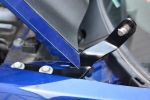 |
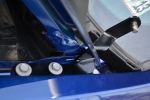 |
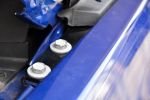 |
1. Scott started by opening the truck hood and removing the hood hinge bracket bolts to attach the truck shock brackets. The truck shock brackets connect the cabover struts to the truck.
2. Next Scott inserted the truck shock brackets into position, on top of the hood hinge bracket, and reinstalled the hood hinge bracket bolts. This completed the truck shock bracket installation.
3. With the shock brackets installed, Scott turned his attention to installing the camper shock brackets. The camper shock brackets attach the cabover struts to the camper on each side of the cabover.
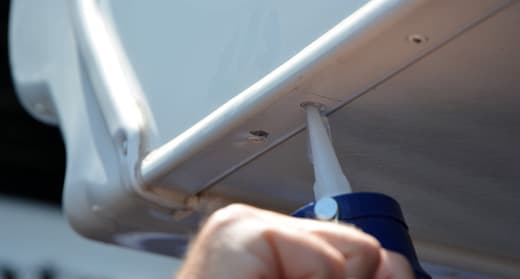
Above: Scott applied sealant before securing the camper shock brackets
To find the proper attachment point for the camper shock brackets, Scott attached the cabover struts to the truck shock brackets and angled them towards the cabover. He then found the point on the cabover where the inside cabover strut piston would be extended halfway. This half-way extension point gives the up and down movement of the camper the greatest amount of available travel within the cabover strut.
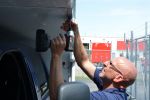 |
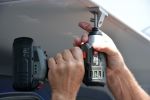 |
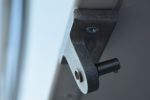 |
4. Once he had found the proper attachment point for the camper shock brackets, Scott drilled the camper shock brackets into the camper cabover with two screws for each camper shock bracket.
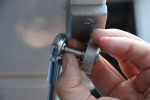 |
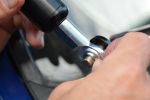 |
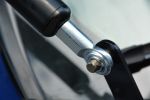 |
5. The final step in the installation is to attach the cabover struts to the truck and camper brackets. As the cabover struts themselves come pre-assembled, this is simply a matter of lining up the struts to the brackets and pushing in a small pin on the brackets allowing the strut to move into position. The pins then hold the struts in place.
During our cabover strut tests we installed and removed the cabover struts about a dozen times. Once you get accustomed to how to line up the strut and push in the pins, taking the struts on and off takes less than a minute.
WAF Alert: The Wife Acceptance Factor
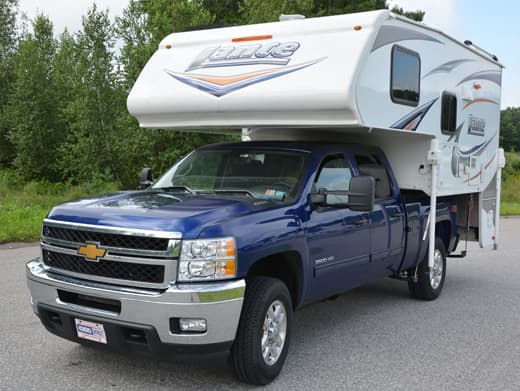
Above: Our rig without cabover struts
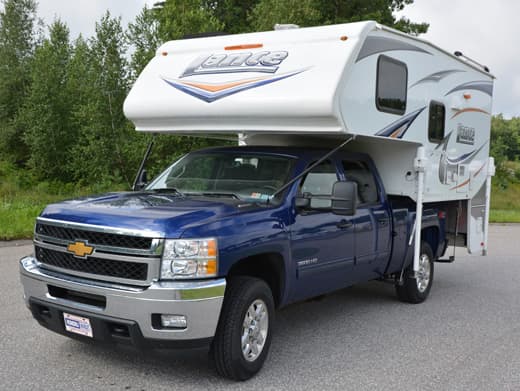
Above: Our rig with cabover struts installed
When Angela came out to see the rig with the struts installed, she paused. I could tell by her facial expression that she wasn’t exactly pleased with the aesthetics of two black tubes on the front of our rig.
The cabover struts are quite pronounced and change the overall presentation of the truck camper. You can also see the struts from inside the truck cab, but they’re not distracting and do not block your vision while driving.
The “Ga-Dunk, Ga-Dunk” Lance Cabover Strut Review
If ever we wanted to find a state where we could test the cabover struts for porpoising (AKA highway hopping), Michigan was perfect. Almost immediately after leaving American RV, we hit a ribbed concrete highway.
Before installing the cabover struts, our rig would porpoise and hop on some concrete highways, the dreaded “ga-dunk, ga-gunk, ga-dunk…”. It wasn’t so bad that it affected the drivability or handling of the rig, it was just annoying. With the cabover struts installed, that highway hopping was nearly eliminated. The difference wasn’t subtle. The annoying ga-dunks were all but ga-gone.
As we drove down the highway, I enjoyed watching where the cabover strut met the truck camper. I could literally see the strut piston moving with the camper to absorb the road bumps and undulations. It’s pretty cool to watch, and, with our admittedly brand new set of cabover struts, completely silent.
On our way back to Pennsylvania, we drove on all manners of highway quality; fresh asphalt to, “Look-out-for-that-pothole!” parkways. Outside of the concrete “ga-dunk, ga-dunk” roads, we struggled to tell any difference in the rig’s handling or ride comfort compared to not using the cabover struts. That impression lasted until we did the video tests back home.
GoPro Hero3 Black Edition Video Tests
When we returned home to Pennsylvania, we started to seek out bad roads and common road obstacles including speed bumps, rail road tracks, and pesky parking lot curbs. We were looking for anything that might jar the front suspension or rock the camper to give the cabover struts a real world stress test.
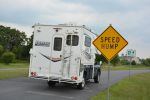 |
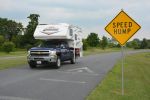 |
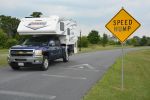 |
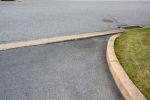 |
 |
 |
Top: The speed bump course. Bottom: The curb entry and exit course.
In the end, we settled on a set of large speed bumps, a short loop that includes two nasty parking lot curbs, and a short stretch of concrete highway that has “ga-dunk, ga-dunk” written all over it. We tried several train track intersections near us, but they’re all nicely and filled in and relatively smooth. How typical is it that we couldn’t find a jarring set of rail road tracks when we needed them?
Watching the cabover struts out the window gave us the idea to use a mountable high-definition fixed-lens GoPro Hero3 Black Edition camera to record the movement of the camper as we went over these different road surfaces and obstacles. The nose of the camper would act like a sort-of seismograph indicating the movement of the camper in relation to the truck.
For the test, we would drive over the selected road obstacles at equal speed with the cabover struts installed, and uninstalled, and record the movement of the camper from a fixed and identical position with the GoPro. Then we would take the resulting GoPro videos and put them side-by-side to reveal if the cabover struts are effecting the movement of the camper over a given obstacle, or not.
Above: Lance Camper Cabover Strut Video Test
To watch the above video in High Definition, press play, click on the quality “wheel” symbol in the lower right corner of the YouTube screen, and select 720p or 1080p. High Definition video will take longer to load and play. Click on the box in the lower right corner of the YouTube window to view the video full screen.
During the tests, it became clear that the struts were having a positive effect on the control of the movement of the camper almost all the time. This effect was only evident after taking the cabover struts on and off and then going over the same obstacles.
To be clear, the difference in ride comfort and handling is very subtle. The only situation where the perceived difference wasn’t subtle was the concrete highway. There, once again, the cabover struts really smoothed out the ga-dunk ga-dunks.
We were quite surprised when we watched the GoPro video as it shows much more camper control by the cabover struts than we could perceive in the truck. With the cabover struts installed, the camper still moves when the truck encounters an obstacle, but the movement appears to be absorbed faster and is less violent with the cabover struts installed.
Two Precautions
Anyone considering cabover struts needs to consider two precautions. First, cabover struts must be removed before demounting the truck camper to avoid potentially serious damage to your truck and camper. Cabover struts also need to be removed if you level the camper within the truck. Most of us would remember to remove the cabover struts before demounting or leveling without fail, but one mistake could be very costly.
Perhaps a, “Struts Off?” sticker on your camper jack remote or drill (for mechanical jack owners) would help. Don’t laugh, we have heard reports about this accident actually happening.
Second, you need to check with your truck camper manufacturer to make sure there is sufficient blocking and support where the cabover struts will attach to the underside of the cabover. Do not install cabover struts without consulting with your truck camper manufacturer first. Again, this could be a very costly mistake.
If there is a third precaution, it would be aesthetics. Yes, we’re nit-picking, but cabover struts just aren’t that sexy. Admittedly, the struts got sexier to us as we began to experience their impressive anti-ga-dunk ga-dunk qualities. Some things get cuter as you get to know them.
Wrap It up
Based on our experience and tests, it seems clear that our truck camping forbearers knew exactly what they were doing when they installed cabover struts on their rigs. Forty years after their heyday, cabover struts still do what they are designed to do; greatly diminish highway porpoising and excess camper motion.
Addressing highway porpoising is the primary benefit of cabover struts, and their key strength. As our video shows, they do work in other driving conditions, but the experienced benefit is subtle.
Based on our cabover strut experience and test results, we recommend cabover struts to truck camper rig owners who suffer from excessive highway porpoising, and/or excessive camper motion.
Cabover Strut Long Term User Feedback
To get feedback on long term cabover strut experience with truck campers, we contacted Truck Camper Magazine readers who have used cabover struts over several years. Click here to read their feedback on long term cabover strut use.
Check out the Lance Camper Buyers Guide to see all models. For more information on Lance Campers, visit the Lance website at lancecamper.com. Click here to request a free Lance brochure.
